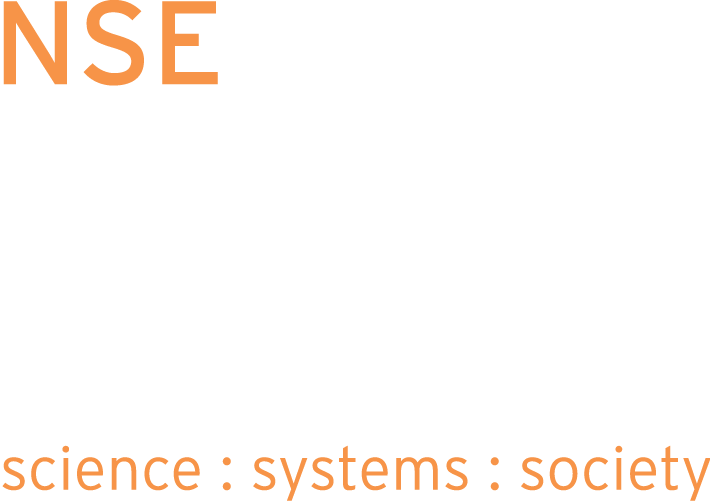Open UROP Positions (22)
Challenging research opportunities exist for undergraduates of all levels in Course 22,
especially for freshmen, through MIT's Undergraduate Research Opportunities Program (UROP).
Join our faculty, students, and staff on cutting-edge research projects for credit or pay,
and get hands-on experience on the research that the NSE department has to offer. Our UROPs
are all NO EXPERIENCE REQUIRED unless stated otherwise.
You are encouraged to browse the research sections of the NSE website to learn more about the areas of research that Department faculty are engaged in. Undergraduate research opportunities may not always be listed with MIT's UROP Office. Heather Barry in the NSE Undergraduate Program Office and Prof. Matteo Bucci, NSE's UROP Coordinator, will help you find a UROP in Course 22.
Check out our Open UROP Positions to start your research career in Course 22 today!
You are encouraged to browse the research sections of the NSE website to learn more about the areas of research that Department faculty are engaged in. Undergraduate research opportunities may not always be listed with MIT's UROP Office. Heather Barry in the NSE Undergraduate Program Office and Prof. Matteo Bucci, NSE's UROP Coordinator, will help you find a UROP in Course 22.
Check out our Open UROP Positions to start your research career in Course 22 today!
COMSOL Modeling Mongolian Gers for Million-Person Scale Decarbonization
Contact: Nathan MelenbrinkPosting Date: 2024-02-20
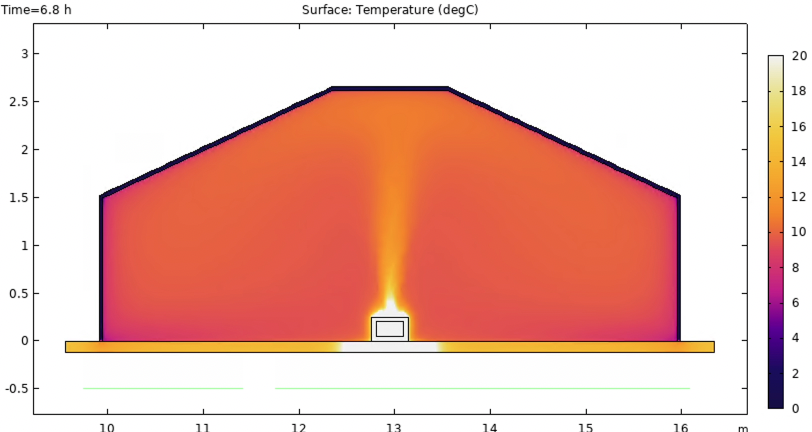
COMSOL model of a molten salt thermal brick heating a Mongolian ger
UROP Description: We’re seeking a UROP with some experience in COMSOL Multiphysics (or at least a desire to learn) for conducting heat transfer simulations at an architectural scale. This is part of the collaboration between NEET/NSE and the National University of Mongolia, where phase-change material thermal batteries are proposed as an alternative to burning coal inside of traditional ger residences. The goal is to identify the amount of solar salt needed to maintain sufficient warmth in a Mongolian ger throughout the duration of a cold (-40 C) winter night. More information about the project can be found here as well as a video here. While the initial Comsol model has already been built, the UROP will update and refine the model, and use it to investigate (1) alternative phase change materials and quantities and (2) alternative insulating materials and thicknesses, especially scenarios where insulation is incrementally removed over a 12-hour period, thereby affecting the rate of cooling.
Tags:
Residential Heat Storage Using Molten Salts
Contact: David Cohen-TanugiPosting Date: 2024-02-12
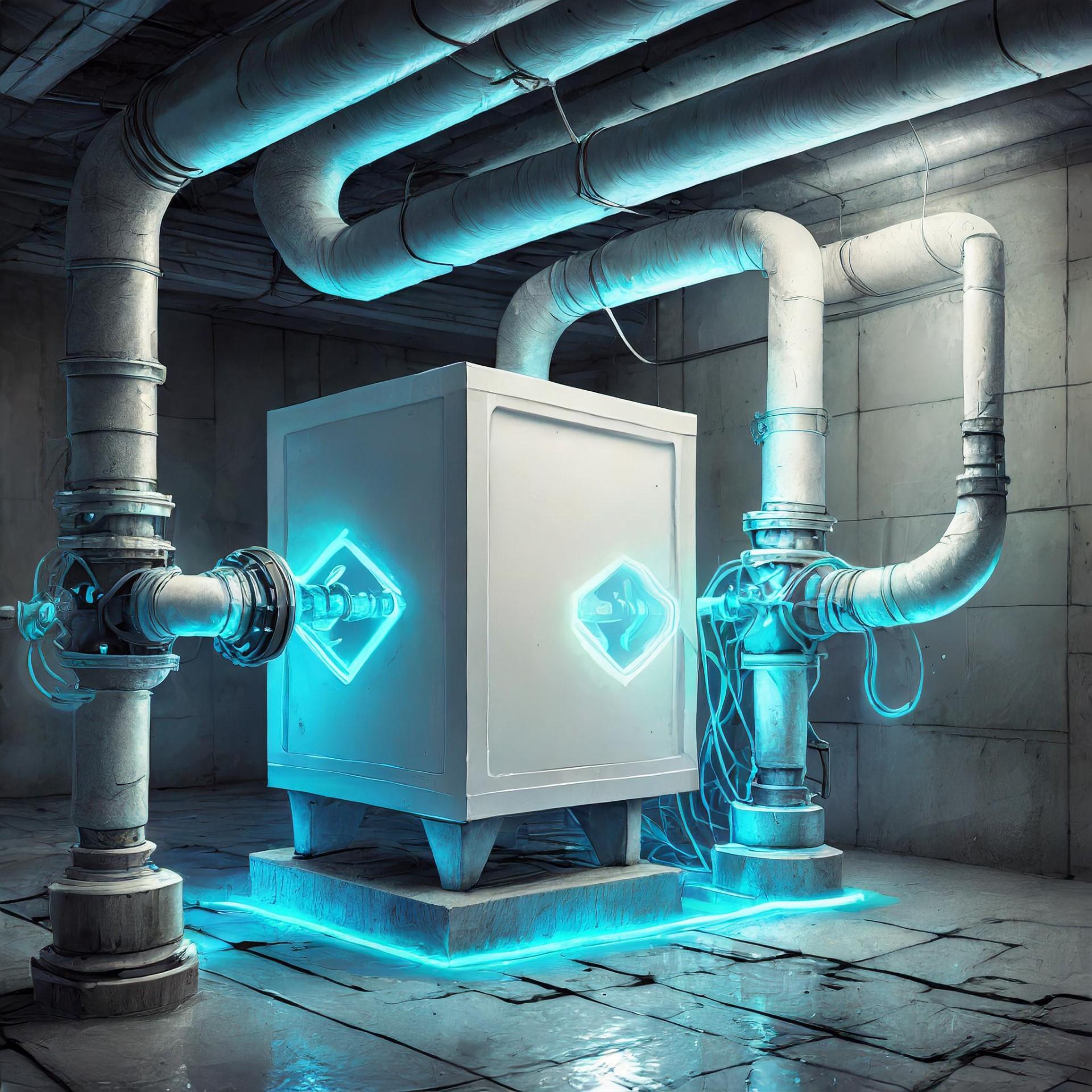
AI-generated artist’s rendering of a molten salt system for residential heat storage (Adobe Firefly)
UROP Description: The rapid growth of solar power is helping make electricity increasingly affordable during daylight hours. However, the sun doesn't shine at night, whereas many consumers need residential heat & hot water after sunset. Fossil power plants are no longer a sustainable way to meet this evening demand, and Li-ion batteries are too costly to power the majority of residential heating load. This UROP project aims to investigate the technical and economic feasibility of a molten salt heat storage system for residential heating. The proposed system utilizes daytime electricity to heat molten salt, for example in a home's basement, storing energy for later use in heating homes. This is an opportunity for a talented and motivated UROP to perform a techno-economic analysis of this proposed system, including the efficiency of converting electricity to thermal energy, thermal transfer mechanisms to water and air for residential heating applications, installation and operational costs, etc. The environmental impact, including reduced reliance on fossil fuels and lower carbon emissions, will also be examined. This project seeks to provide detailed insights into molten salt heat storage systems, offering valuable recommendations for integration and scalability. The outcomes of this research will contribute to the development of sustainable residential heating solutions, aligning with the increasing demand for eco-friendly alternatives.
Preferred Experience: Techno-economic analysis; Thermal-fluids engineering (2.005 or equivalent)
Tags:


Ar pumpout by ICRF waves in C-Mod L- and I-mode plasmas
Contact: Dr. John Rice, Conor PerksPosting Date: 2023-12-07
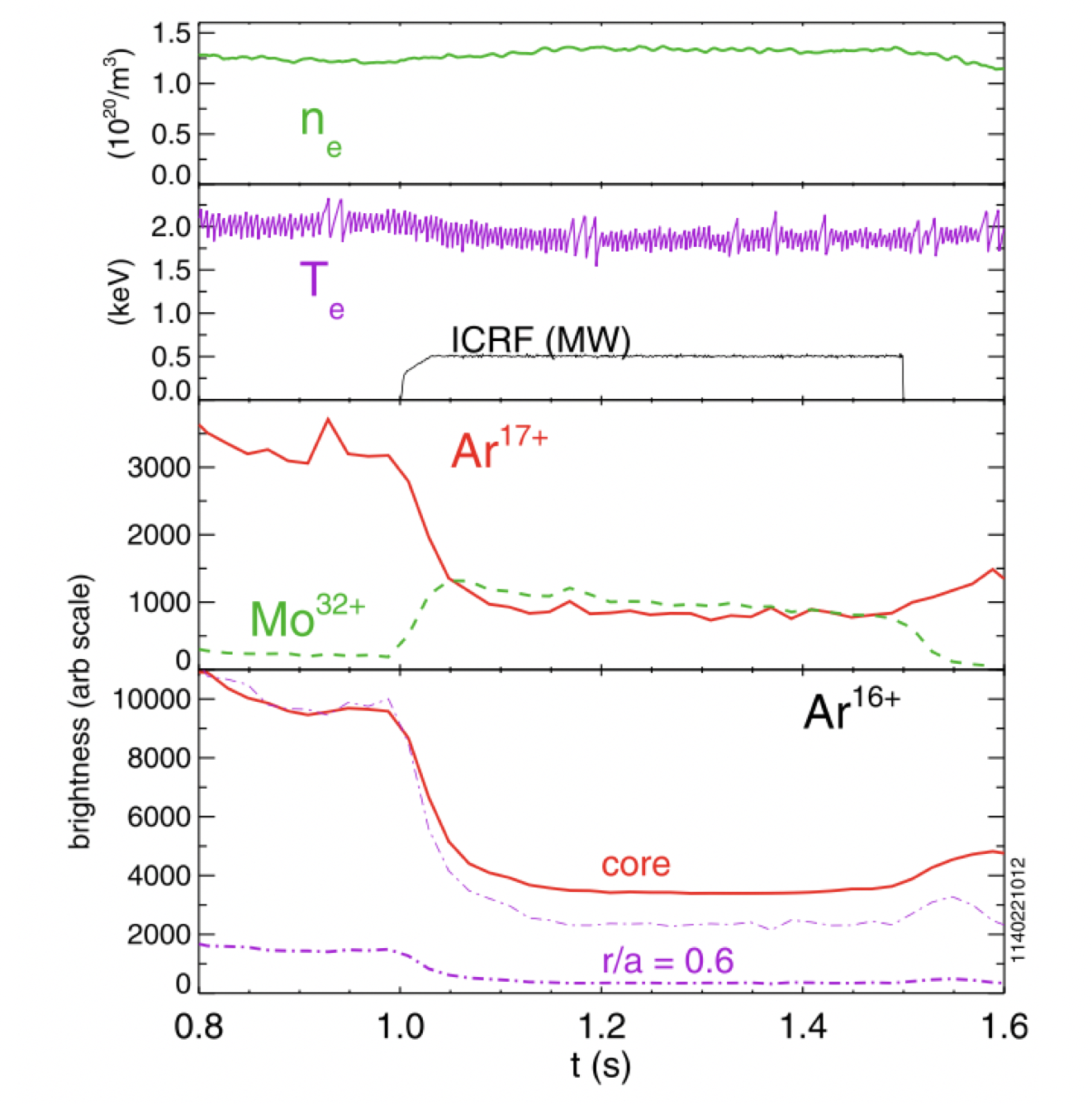
Figure: Observed spectroscopic signal from argon charge states (bottom two panels, red & purple lines) when the Ion Cyclotron Range of Frequencies (ICRF) heating is energized (2nd panel, black line) in plasmas with substantial hydrogen-to-deuterium re
UROP Description:
PI: Dr. John Rice (senior research scientist)
Direct Supervisor: Conor Perks (graduate student)
In future fusion reactors, impurity accumulation, particularly from heavy ions such as tungsten, is a concern due to how efficiently impurities cool the plasmas. Our group is working to characterize the transport mechanism causing the observed reduction in impurity density and then leveraging this mechanism to control tungsten accumulation in the SPARC tokamak. We’re exploring various computational and experimental approaches, but one aspect that would be helpful to have a UROP for would be to calculate the ion energy distribution functions caused by the ICRF interaction with the argon ions. Conor has two codes almost entirely prepared to do such a calculation: one via a Monte Carlo sampling of how the ion orbits change in time using the ASCOT4-RFOF code; another is a continuum approach solving the Vlasov-Maxwell system of equations using the AORSA code coupled to the CQL3D code. A student must finish preparing these codes to be used and then analyze various C-Mod shots. The intent is to cross-validate the energy distribution functions from these two methods and then cross-validate the inferred transport from experimental methods already underway.
Preferred Experience: Good coding practices, Github, basic electrodynamics, basic statistical mechanics, experience coding in python, Matlab, Fortran
Tags:

Accelerated Data Processing for Digital Image Correlations (DIC) in Advanced Nuclear Fuels Testing
Contact: Lorenzo MazzoccoPosting Date: 2023-09-13
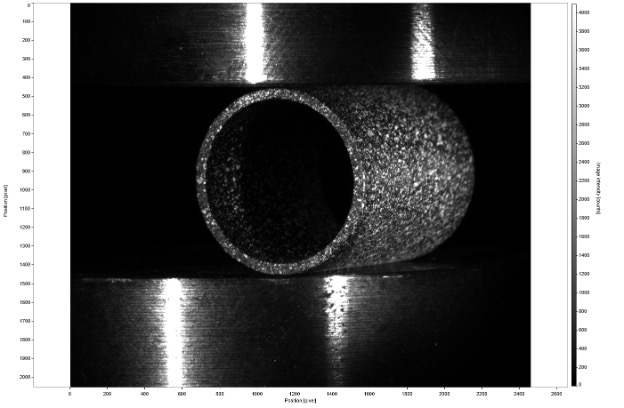
Sample of Zircaloy cladding undergoing a ring compression test in the Nuclear Reactor Laboratory
UROP Description: Comprehensive mechanical testing at the engineering scale is required for the adoption of accident tolerant fuel in commercial nuclear reactors. By coupling a stereo camera system to the mechanical testing apparatus we are trying to better validate Finite Element models and gather information that will eventually allow us to reliably extract quantitative material properties of irradiated cladding materials from mechanical tests that previously have only been used to extract qualitative information.
In this UROP you will develop accelerated data processing capabilities to support Digital Image Correlations (DIC) techniques. You will research how to optimize speckle patterns on cladding samples, then you will compare different software solutions for both 2D and 3D Digital Image Correlation. You will implement machine learning algorithms to postprocess DIC data. You will develop scripts to quantify the error between the 2D and 3D displacement fields obtained experimentally, and the ones generated by Finite Element Analysis (via the software Abaqus).
This project will require strong programming skills (either in Python, MATLAB or C++) and basic understanding of image processing. Students interested in mechanical engineering and/or material science are encouraged to apply.
Tags:

Warhead Verification with Electric Cryptography
Contact: Prof. Areg DanagoulianPosting Date: 2023-09-06
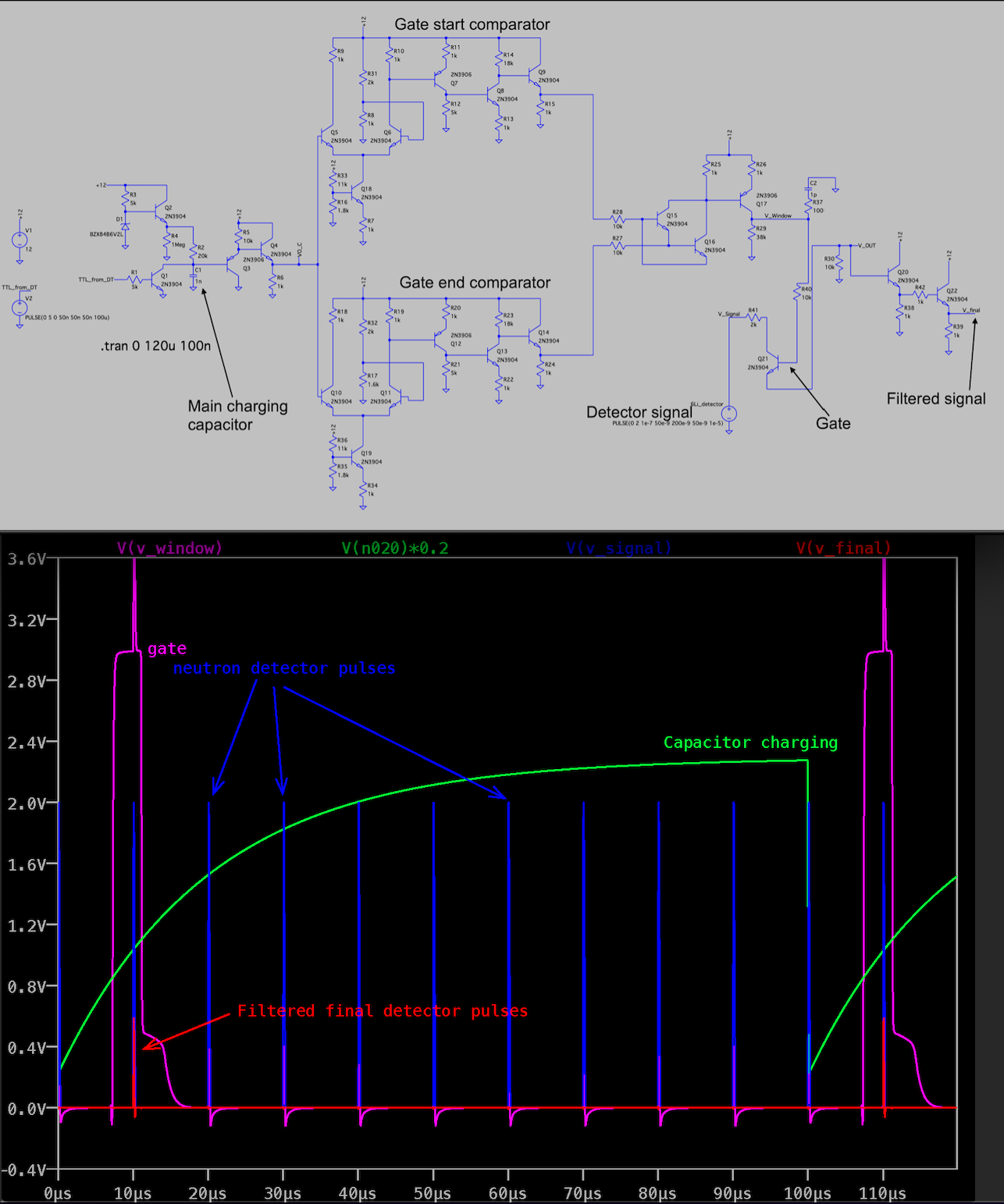
The full circuit design in LTSpice (top) and Filtering of the detector signal (bottom)
UROP Description: Warhead verification needs to achieve the three goals of a Zero Knowledge Proof (ZKP): sensitivity to a hoax; specificity; privacy. Research efforts by MIT have shown that epithermal neutron beams can be used in time-of-flight (TOF) mode to achieve these three goals in a physically cryptographic manner. Furthermore, efforts by MIT and Princeton , as well as more recent collaborative efforts between PNNL and MIT have shown that compact, DT-generator based beams can be used to differentiate between various fissile isotopes. We want to go one step further and achieve ZKP by abandoning the digital realm and instead using a system consisting of a limited number (40-100) of analog electrical components, such as ~cm scale resistors, capacitors, and bipolar junction transistors. Such a system will filter out the TOF signal and produce just simple counts in particular energy windows. These counts then can be used to perform verification, without revealing any additional information. The simplest way of achieving this, using analog devices, is to switch from time domain to voltage domain using a simple charging capacitor in RC configuration. See the top figure for the circuit layout of the proposed system. Here the DT generates the t0, which starts the charging of the capacitor. Preliminary circuit design has been performed -- the circuit has been simulated in LTspice as well as breadboard-level circuitry. The bottom figure shows the evolution of the detector signal, as it passes through the filtering gate. The filtered signal (red) shows suppression of all pulses which do not fall into the gate. This filtered signal can then be used to either trigger a mechanical analog counter, or be fed into an analog-circuit based ripple counter.
Contact: Areg Danagoulian (aregjan@mit.edu)
Tags:

Detector control software for a diffractometer at the MIT Reactor
Contact: Dr. Boris KhaykovichPosting Date: 2023-01-17

UROP Description:
Neutron scattering is a widely used collection of techniques with applications in materials science, physics, and chemistry. At the MIT Reactor, we are building a prototype of a novel diffractometer using position-sensitive gas and scintillator neutron detectors. The student will help build the instrument-control software, especially for detector readout. The project will likely require writing a Python wrapper to control the instrument using existing C++ libraries for the electronics readout. We could utilize the Python-based Bluesky Data Collection Framework (https://blueskyproject.io/bluesky/index.html). Another option is to use LabView, a graphical instrumentation-control software. Proficiency with Python and some knowledge of C++ are required. Students interested in nuclear experimental techniques, or hardware-software interfaces are welcome to apply.
Tags:


The Cost of Nuclear-Grade Coolants for Advanced Nuclear Reactors
Contact: Prof. Jacopo BuongiornoPosting Date: 2022-12-15

UROP Description:
Objectives
Assess the cost ($/kg) of nuclear-grade coolants to be used in advanced nuclear energy systems, both fission and fusion.
Students
We shall hire 1 or 2 UG students. MIT students from all majors and all years are welcome to apply, with a preference for Course 22 students. Students can participate in this project for pay through sponsored research from the Department or for credit, at the student’s discretion.
Background and Scope of Work
The vast majority of advanced nuclear energy systems (both fission and fusion) use coolant fluids other than water. Examples include liquid sodium, liquid salt (FLiBe), liquid lead-bismuth eutectic (LBE) and helium gas. While the thermophysical properties of all these coolants are well known, their cost, when the appropriate nuclear-grade characteristics are accounted for, is not. A credible estimate of all the costs associated with such coolants must include raw material supply, transportation, initial purification to nuclear-grade specifications, chemistry control during operation and disposal.
In this UROP project we seek to develop a comprehensive estimate of the unit cost ($/kg) for each of the advanced coolants mentioned above. The UROP student(s) will collect, organize and analyze the relevant information from the open literature, as well as from materials suppliers and reactor vendors.
The main deliverable for this project is a brief report describing all the results, assumptions and sources used in the project.
Contact
Students interested in this project should contact Prof. Jacopo Buongiorno at jacopo@mit.edu.
Tags:
Design and Modification of Thermal Hydraulic Demo Facility
Contact: Prof. Jacopo BuongiornoPosting Date: 2022-12-06

Picture of existing demo loop
UROP Description:
Objectives
This project will be to design multiple changes and modify a thermal hydraulic facility used to demonstrate single-phase and two-phase natural circulation. The facility also demonstrates flow regimes for two-phase flow. The modifications to the existing facility will include re-pipping to make the facility easier to operate, adding a thermostat to the heater, designing a phase separator, and adding a pump to the system for optional forced flow. The demonstration facility will be used to for instruction purposes in both MIT courses and summer workshops.
Students
We shall hire 1 UG students. MIT students from all majors and all years are welcome to apply. Students can participate in this project for pay through sponsored research from the department or for credit, at the student’s discretion.
Scope of Work
The student and faculty will:
• design the modifications to the thermal hydraulic facility to fit within the given design envelope of cost, space, and operational constraints;
• modify the facility in NW13-253;
• shakedown the facility showing proper operation, and ability to visually demonstrate the desired phenomena;
• write a simple operating procedure for the facility.
The main deliverable for this project is a working thermal hydraulic physical model demonstrating single-phase natural circulation, two-phase natural circulation, and two-phase flow regimes. The second deliverable is a short document describing the demo’s operation.
Contact
Students interested in this project should contact Prof. Jacopo Buongiorno at jacopo@mit.edu or Dr. Bren Phillips at bren@mit.edu
Tags:
100-Gigawatt-Hour Heat Storage for Nuclear, CSP and Thermal Batteries
Contact: Dr. Charles ForsbergPosting Date: 2022-09-14
UROP Description:
Objective
Fossil fuels are remarkable: low-cost, easy to store and easy to transport. All of the replacement technologies (nuclear, wind, solar, fossil fuels with carbon capture and sequestration (CCS)) for a low-carbon future have high capital costs. Low-cost very-large energy storage is required to enable operating these technologies at full capacity while providing variable electricity and heat to industry. The UROP is to examine ultra-low-cost heat storage using crushed rock in a pile 20 to 40 meters high, a dozen football fields in size and located inside an insulated building. Heat is transferred from the nuclear reactor to the rock by (1) spraying hot fluid on top of the rock, (2) the fluid trickling through the crushed rock while heating the rock and flowing to the drain pans below and (3) returning to the reactor to be re-heated. To recover the heat, (1) cold fluid is sprayed on top of hot crushed rock, (2) trickles through the crushed rock, (3) is caught as hot fluid by the drain pans at the bottom of the crushed rock pile and (4) is sent to the power cycle to produce variable electricity to the grid. The estimated capital cost is 5 to 10 times less than other heat storage technologies such as the two-tank nitrate storage systems used in CSP plants and proposed for advanced nuclear reactors. Such low-cost storage would enable hourly to seasonal heat storage and enable a base-load nuclear reactor to operate like a gas turbine to provide variable power to the grid.
Scope of work
We have multiple scopes of work: (1) estimating heat losses from hot crushed rock to the environment, (2) understanding how the hot fluid flows downward through the crushed rock, (3) developing options to initially heat the rock above the freezing point of the salt heat transfer fluid so it does not freeze in the crushed rock during initial startup and (4) understanding how steep can the sides of the rock pile be and remain stable.
Tags:
Studying the dynamics of electrochemical ionic synapses using an electrochemical equivalent circuit model
Contact: Prof. Bilge YildizPosting Date: 2022-09-12
UROP Description:
Background
Physical neural networks made of analog programmable resistors are promising platforms for analog computing and for emulating biological systems. Electrochemical ionic synapses are a new type of analog programmable resistor that have shown deterministic, charge-controlled resistance modulations with energy efficiency on par with biological synapses. The operations of electrochemical ionic synapses are based on the shuffling of ions across active device layers that control the conductance of a channel in a three-terminal configuration. Understanding physical processes and behaviors of these devices is important for successfully applying them in brain-inspired computing systems.
Scope of Work
We have developed a preliminary electrochemical equivalent circuit model for these devices using MATLAB, and we are interested in having a UROP to support our research on understanding various behaviors and dynamics that can be expected from the devices using the model. In this project, you will carry out simulations to systematically explore the effect of different material parameters and different voltage/current waveforms on the response of the devices. The predicted responses will be verified and compared with experimental measurements. Your work will hopefully contribute to the development of a novel hardware architecture for bio-inspired computing.
Contact
Please contact Prof. Bilge Yildiz (byildiz@mit.edu) and/or Dr. Mantao Huang (mantao@mit.edu).
Tags:
Development and Testing of a Calorimeter for Confirmatory Measurements of Gamma Field in the MITR 3GV Position
Contact: Dr. Sacit CetinerPosting Date: 2022-09-08
UROP Description:
Objectives
This project will develop a concept, conduct thermal design iterations and optimization, and fabricate a small-size device as a confirmatory measurement tool for the characterization of the gamma field in the MITR 3GV facility. This assignment is closely related to the ‘Neutron Flux and Gamma Field Characterization in the MITR 3GV Position’ as it will provide a diverse, independent and confirmatory measurement distinctly for the gamma heating. Likewise, this activity is being conducted in preparation for an upcoming experiment in support of the Nuclear Thermal Propulsion (NTP) work funded by the National Aeronautics and Space Administration (NASA). The measurements are an important part of the overall project scope as they will establish validation for the computational models used in the concept design. Moreover, these experimental measurements will be critical in the synthesis of the control system for the final demonstration.
Scope of Work
Gamma thermometers are used in power reactors either as local power range monitors, or as reference instruments for calibration of primary nuclear instrumentation. The term ‘thermometer’ is in fact a misnomer as the instrument does not produce a temperature signal. On the contrary, its operating principle is heat balance along a controlled heat conduction path. Therefore, the final signal output is correlated to local heat deposition rate within a specified volume. As the neutron flux in the 3GV6 position is highly thermalized, the heat generated within the volume is expected to be predominantly due to the gamma field.
In this assignment, you will perform thermal design calculations using commercial finite-element analysis (FEA) tools. In the conduct of the design, you will be interacting with the rest of the design team to receive the volumetric heat generation rates for your design calculations. Similarly, you will generate component dimensions to be incorporated into the overall experiment.
We will hire one undergraduate student. MIT students from relevant backgrounds are welcome to apply. Students can participate in this project for pay through sponsored research from the NRL or for credit—at the student’s discretion.
Contact
Students interested in this project should contact Dr. Sacit Cetiner at sacit@mit.edu.
Tags:
Prospects for reducing the cost of nuclear energy to address climate change
Contact: Prof. R. Scott KempPosting Date: 2022-09-08
UROP Description: While nuclear reactors are a major source of low-carbon electricity, very little nuclear power is built because the technology is too expensive for most Western nations. In this UROP, we will analyze the historical build cost of nuclear reactors to determine how economies of scale, repeating builds of the same reactor design (Nth of a kind), and national experience with building reactors shapes the cost of nuclear power. Our goal is to assess from empirical data whether a renaissance in nuclear power could ultimately deliver reactors that are competitive with wind and solar. The student will analyze data provided by the advisor and build a multivariate regression model using MatLab or other appropriate software package. Prior coursework in economics, econometrics, or machine learning (e.g., model selection) is preferred.
Terms: Fall and Spring
Estimated hours per week: 3-6
PI: R. Scott Kemp (rsk@mit.edu)
Program: Laboratory for Nuclear Security and Policy
Website: LNSP.mit.edu
Tags:
Design and Construction of a Cryogenic Pump for Space Applications Research
Contact: Prof. Matteo BucciPosting Date: 2022-09-08
UROP Description:
Background
Cryogenic pumps are used in many applications, as diverse as particle accelerators, atomic force microscopes, plant for natural gas liquification, food industry and space exploration system. Off-the-shelf pumps are available for Nitrogen while custom pumps can be ordered for Hydrogen or Helium. However, the operating range of commercial pump are limited to specific flow rates and pressure heads. With this project we aim to realize a simple design for a versatile pump that can work with cryogenic fluids at a low flow rate. This pump will be used for lab experiments, satellite cooling and small cryogenic equipment, in the context of research programs devoted to improve the understanding of boiling heat transfer with cryogenic fluids in space systems.
Scope of work
The student will design the cryogenic pump by applying physical principle and critical thinking and leveraging existing literature designs. The student will build the prototype by using 3D printers and CNC devices (the machining part could be outsourced), and test it in laboratory conditions. We anticipate challenging goals in the pump design such as avoiding cavitation phenomena and reducing the build up of vapor phase in the pump discharge. The final delivery of the work is a functioning prototype of a pump that is able to work with liquid Nitrogen and that could be tested to work with liquid Neon and Liquid Hydrogen.
Contact
Please contact Marco Graffiedi (mgraff@mit.edu) or Prof. Matteo Bucci (mbucci@mit.edu)
Tags:
Neutron Flux and Gamma Field Characterization in the MITR 3GV Position
Contact: Dr. Sacit CetinerPosting Date: 2022-09-08
UROP Description:
Objectives
This project will perform nuclear measurements in the 3GV6 position of the MITR to characterize the neutron flux and gamma field in preparation for an upcoming experiment in support of the Nuclear Thermal Propulsion (NTP) work funded by the National Aeronautics and Space Administration (NASA). The measurements are an important part of the overall project scope as they will establish validation for the computational models used in the concept design. Moreover, these experimental measurements will be critical in the synthesis of the control system for the final demonstration.
Scope of Work
In this project, you will work closely with the INL/MIT Center for Reactor Instrumentation and Sensor Physics (CRISP) and Nuclear Reactor Laboratory (NRL) scientists during the preparation and the conduct of the experiments. The principal technique in characterizing the neutron flux is known as the neutron activation analysis (NAA). The measurements will conform to the process established by the American Society for Testing and Materials (ASTM), and specifically the standards ASTM E261-16, E262-17, E263-18, E264-19, and E481-16. These standards provide a widely accepted consensus set of procedures in these measurements as well as quantification of uncertainties. In addition to the NRL/MITR staff, you will also be mentored by the experts at the Idaho National Laboratory (INL). These interactions will most likely lead to future internship opportunities at the Advanced Test Reactor (ATR) or the Transient Reactor Test Facility (TREAT).
We will hire one undergraduate student. MIT students from relevant backgrounds are welcome to apply. Students can participate in this project for pay through sponsored research from the NRL or for credit—at the student’s discretion.
Contact
Students interested in this project should contact Dr. Sacit Cetiner at sacit@mit.edu.
Tags:
Analysis of the microscopic structure of molten salts for energy applications.
Contact: Dr. Gordon Kosher and Dr. Boris KhaykovichPosting Date: 2022-08-17
UROP Description: Molten salts are fascinating liquids important for many applications, such as nuclear and solar energy, and chemical engineering. Dr. Boris Khaykovich and his group are studying the microscopic structure and dynamics of molten salts using neutron and X-ray scattering measurements and computer simulations. The student project is a part of this effort. The student will analyze the data from inelastic X-ray spectroscopy measurements. The data has been recently collected by Dr. Khaykovich and collaborators. The raw data must be properly normalized, filtered, and plotted. Some knowledge of X-ray interaction with matter and/or physical chemistry of solutions will be required. Proficiency with a scripting language such as Matlab or Python and interest in nuclear science and engineering, materials, or chemical engineering is also required.
Tags:
Machine Learning for Levitated Bagel
Contact: Joshua StillermanPosting Date: 2022-02-01
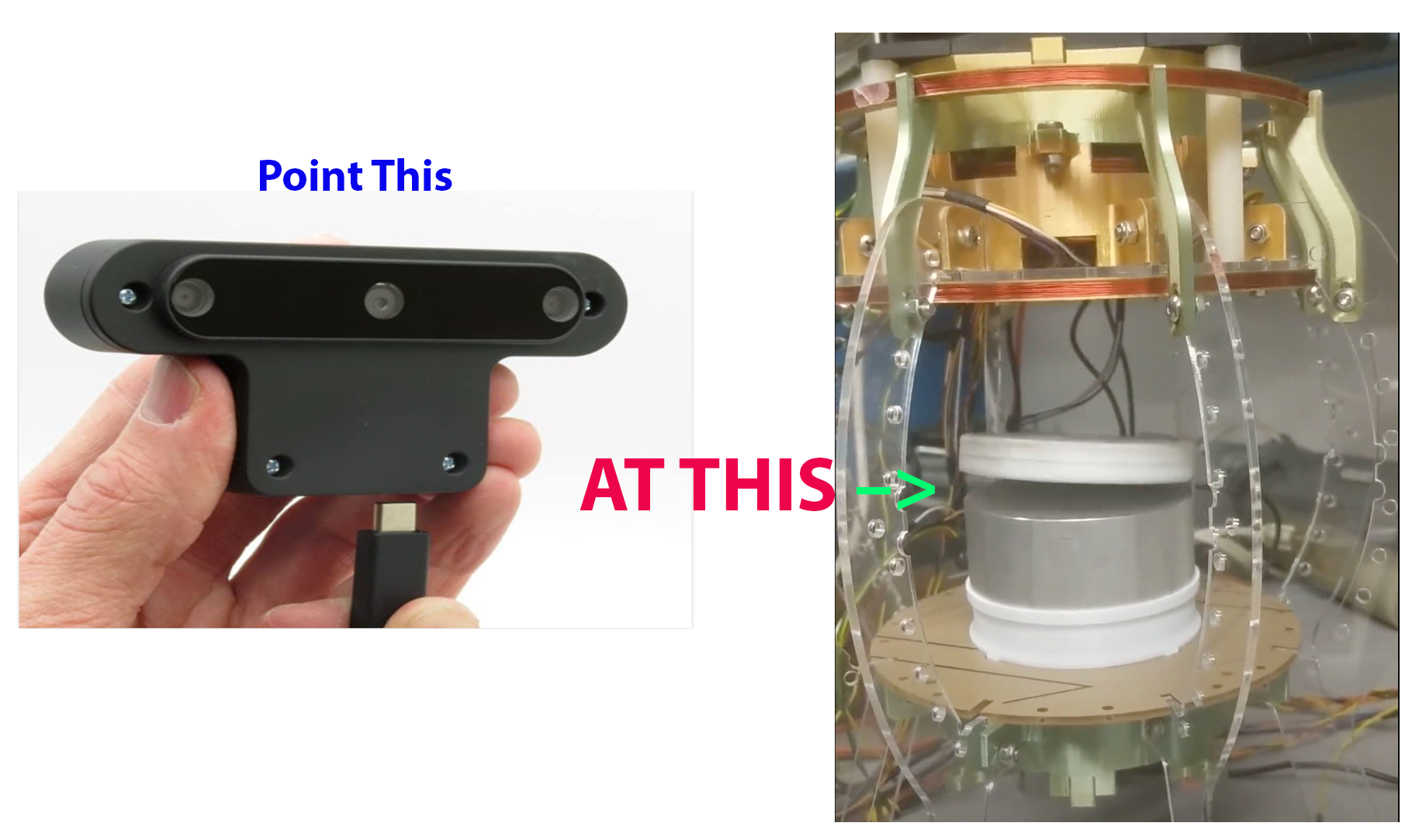
Stereo Camera with Levitated Bagel
UROP Description: Develop a camera based diagnostic for the 'levitated bagel' real-time control demonstration system!
The SPARC tokamak will have a distributed real-time control system with inputs from a wide variety of diagnostics. Simple diagnostics will measure voltages and send them to the controller over the network. This project is a model for higher level image processing diagnostic. You will build a diagnostic using a 'Luxonis Oak-D Spatial AI Camera' with on board machine learning engine to measure position and tilt of the levitated magnet.
A cool project with real hardware you can operate. This is part of the 'proof of principle' that we can integrate a wide array of diagnostics into the control system for the SPARC tokamak.
Tags:
Inertial Confinement Fusion neutron spectrometer redesign simulations with Geant4
Contact: Johan FrenjePosting Date: 2022-01-27
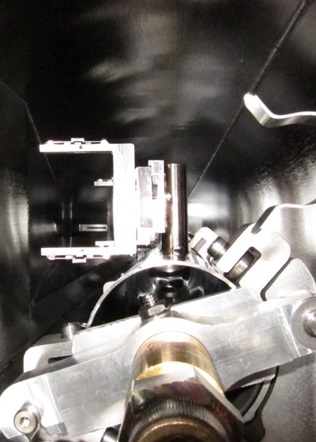
Neutron spectrometer detector targeted for redesign in this project.
UROP Description: The High-Energy-Density Physics (HEDP) Division of the PSFC designs and implements, and performs theoretical calculations for, experiments at the OMEGA laser facility in Rochester, New York, and the National Ignition Facility (NIF) in Livermore, California. These experiments aim to study and explore the dynamics and properties of plasmas under extreme conditions of density (~1000 g/cc), pressure (~ 1000 gigabar), and field strength (~megagauss). These conditions encompass Inertial Confinement Fusion (ICF) as well as many astrophysical phenomena, including collisionless shocks, magnetic reconnection, and nuclear astrophysics. As part of the directly ICF-relevant effort, the group has installed the MRS neutron spectrometer at OMEGA to measure the yield, ion temperature and confinement properties of ICF ignition experiments. This spectrometer measures neutron spectra from the primary cryogenically layered DT implosions on OMEGA, such as described in Ref. [1].
The OMEGA MRS has traditionally primarily measured yield and confinement, but has also been proposed as a means of measuring ion temperature [2]. To accomplish this, the detector array needs to be redesigned to improve the resolution in the measurements. We are seeking a UROP to work on this redesign through simulations using the Geant4 toolkit installed on our Linux cluster. As a first step, this will involve varying simulation setup parameters and compare results to recently obtained calibration data to ensure full understanding of the system as built. A redesign can then be implemented along the lines proposed in Ref. [2]. If a promising redesign can be found, there is potential for the results to be written up for Review of Scientific Instruments.
[1] V. Gopalaswamy et al., Nature 565, 581 (2019).
[2] M. Gatu Johnson et al., Rev. Sci. Instrum. 89, 10I129 (2018).
Tags:
Assessment of plasma response to field errors in SPARC
Contact: Ryan SweeneyPosting Date: 2022-01-27

Electromagnets forming the central transformer in SPARC that are responsible for driving 8.7 MA of plasma current. A cutaway of the plasma is shown with colors indicating the plasma response to the error produced by these magnets.
UROP Description: Plasmas are very sensitive to imperfections in the tokamak magnetic field, so much so that the certain field errors must be on the order of 1 part in 10,000! When the “error fields” are too large, the fusion power is reduced, or even terminated. Designing a magnetic field to this level of precision is not trivial as even the details of how currents flow in the electromagnets matters. This project entails producing simplified line-models of all coils in SPARC, both superconducting and copper, and evaluating the plasma response to the field generated by each line-model. Preparation of the line-models is preferably done by the student in python to leverage existing code. Files are then produced and passed to the Generalized Perturbed Equilibrium Code (GPEC) that solves for the plasma response to this field. GPEC is a powerful analysis tool and understanding how to use it is a valuable skill. In addition to working with Ryan, the student will interact with one of the lead developers of GPEC and a Columbia University professor and expert on error fields. Ryan leads error field studies on SPARC, the engineering design of the error field correction coils, a working group on SPARC disruptions, and contributes to various other systems pertaining to disruptions and diagnostics, so a well performing student is likely to have follow-on opportunities.
Tags:
Breakdown the Cost of Advanced Nuclear Reactors
Contact: Prof. Koroush ShirvanPosting Date: 2021-04-05
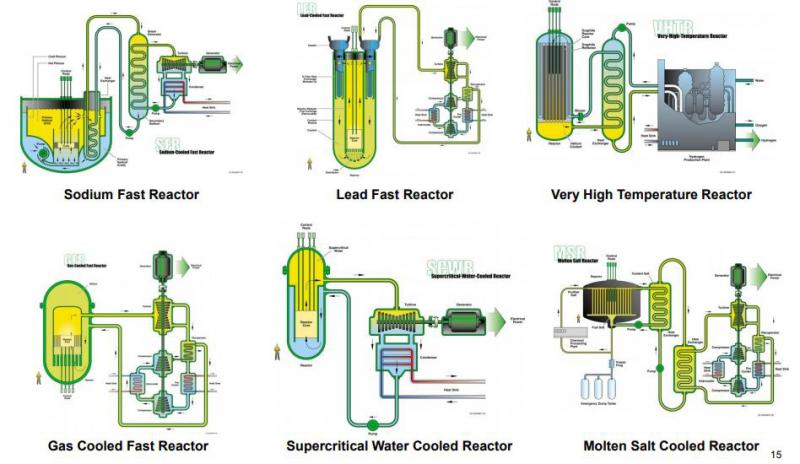
Gen IV Advanced Reactor Technologies
UROP Description: We are developing an open-source cost estimation tool for nuclear technologies. The software is being developed in PYTHON [REF] and we are looking for a UROP to expand its technology choices. Advanced Gen IV nuclear fission reactors have been under development for quite some time. There is a strong renewed interest in deployment of these technologies in the US and abroad. However, it is unclear how much will these new generation of technologies cost with only Russia and China having limited success. The work will focus on gathering material input and cost data for different advanced technologies. When data is not available, good engineering judgment will be employed for best estimation and scaling as well as deciding the associated uncertainties. The data of interest includes size of buildings, amount of steel and concrete, number of heat exchangers, cost of nuclear fuel and its containing structures, etc.
Scope of Work
MIT students from all majors and all years are welcome to apply. Basic programming in PYTHON is preferred. Direct funding is available for this UROP.
Info
For more info, please contact Prof. Shirvan at kshirvan@mit.edu.
Tags:
Multiple UROP positions at the Plasma Science and Fusion Center
Contact: Jessica Coco (PSFC UROP coordinator)Posting Date: 2018-02-03
UROP Description: An important part of the PSFC's activities involves training students who make valuable contributions to the research conducted at the Center. Undergraduate students have an opportunity to work closely with PSFC researchers on projects ranging from experiment design and technology development, to data analysis at all stages throughout their time at MIT, from Freshmen to Seniors. These opportunities are participate in solving the physics and engineering challenges of the future are usually coordinated through the MIT Undergraduate Research Opportunities Program (UROP) or by doing a Senior Thesis in plasma science and fusion.
To learn more about UROPs at the PSFC, contact : psfc-urop@mit.edu.
To find UROPs working on the SPARC project visit : http://www.psfc.mit.edu/sparc/urops.
To learn more about doing a Senior Thesis with a PSFC advisor, contact: psfc-info@mit.edu.
Tags:
Comparative Neutronics Analysis for Tritium Breeding in the LIBRA Experiment
Contact: Stefano SegantinPosting Date: 0000-00-00
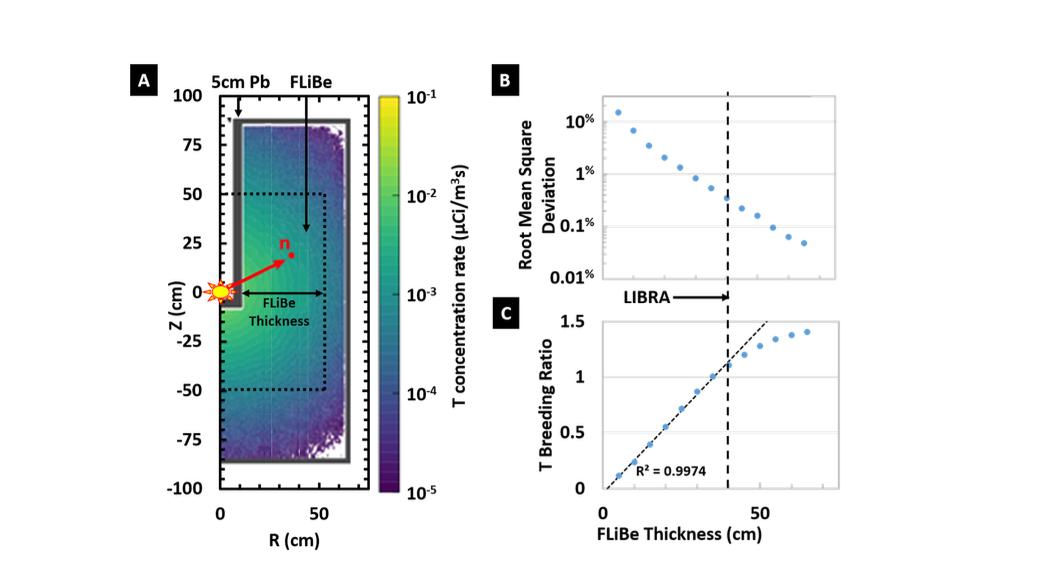
UROP Description: Nuclear fusion stands as a promising and sustainable energy source with the potential to revolutionize the global energy landscape. Among the numerous challenges facing fusion energy, the availability of tritium, a crucial fuel for fusion reactions, is a critical concern. Tritium breeding experiments aim to develop methods for producing tritium within the fusion reactor itself, ensuring a self- sustaining fusion process. This research proposal outlines a study that will apply advanced neutronics techniques to investigate and benchmark CAD-based and Constructive Solid Geometry (CSG) workflows in OpenMC for tritium breeding analysis within the context of the LIBRA Tritium Breeding Experiment.
Objective
The primary objective of this research is to conduct a comprehensive neutronics analysis of the LIBRA Tritium Breeding Experiment, focusing on the bench-marking of CAD-based and CSG workflows against each other and against experimental results. Specifically, we aim to:
• Evaluate the tritium production and breeding performance within the experimental setup.
• Analyze neutron flux, energy spectra, and spatial distributions within the setup.
• Benchmark the CAD-based workflow against the CSG workflow and experimental data to assess their accuracy and performance.
• Provide valuable insights and recommendations for enhancing tritiu bmreeding efficiency in fusion reactors.
Prerequisites
Preferred but not mandatory prerequisites for this research include:
• Proficiency in Python for data analysis and scripting.
• Familiarity with version control systems, such as GitHub, for collaborative code development (preferred).
Literature Review
Tritium breeding in fusion reactors and the associated neutronics analysis techniques have been the subject of extensive research. The OpenMC code, a state-of-the-art Monte Carlo simulation tool for neutron transport, has played a pivotal role in nuclear reactor design and analysis. The investigation and bench- marking of CAD-based and CSG workflows in OpenMC, especially within the context of tritium breeding, is a relatively emerging area of research. This study aims to contribute to the evolving knowledge base in this field.
Expected Results
We anticipate the following outcomes:
• Evaluation of Tritium Production: Assessment of tritium production rates within the experimental setup.
• Neutron Flux Analysis: Analysis of neutron flux distribution, energy spec- tra, and spatial patterns.
• Workflow Benchmarking: Comparative evaluation of the CAD-based and CSG workflows against each other and experimental data, providing in- sights into their accuracy and performance.
• Material and Geometry Impact: Insights into how different materials and geometries affect tritium breeding efficiency.
These results will provide critical information to assess the feasibility and efficiency of tritium breeding in the experimental setup, while also shedding light on the best practices for utilizing advanced neutronics workflows in fusion reactor analysis.
References
1. Ferry, Sara E., et al. ”The LIBRA Experiment: Investigating Robust Tritium Accountancy in Molten FLiBe Exposed to a DT Fusion Neutron Spectrum.” Fusion Science and Technology 79.1 (2023): 13-35. 2. Romano, Paul K., et al. ”OpenMC: A state-of-the-art Monte Carlo code for research and development.” Annals of Nuclear Energy 82 (2015): 90- 97.
Tags:
Alcator C-Mod data analysis for cross-machine comparison and plasma model testing
Contact: Jerry Hughes, Andres MillerPosting Date: 0000-00-00
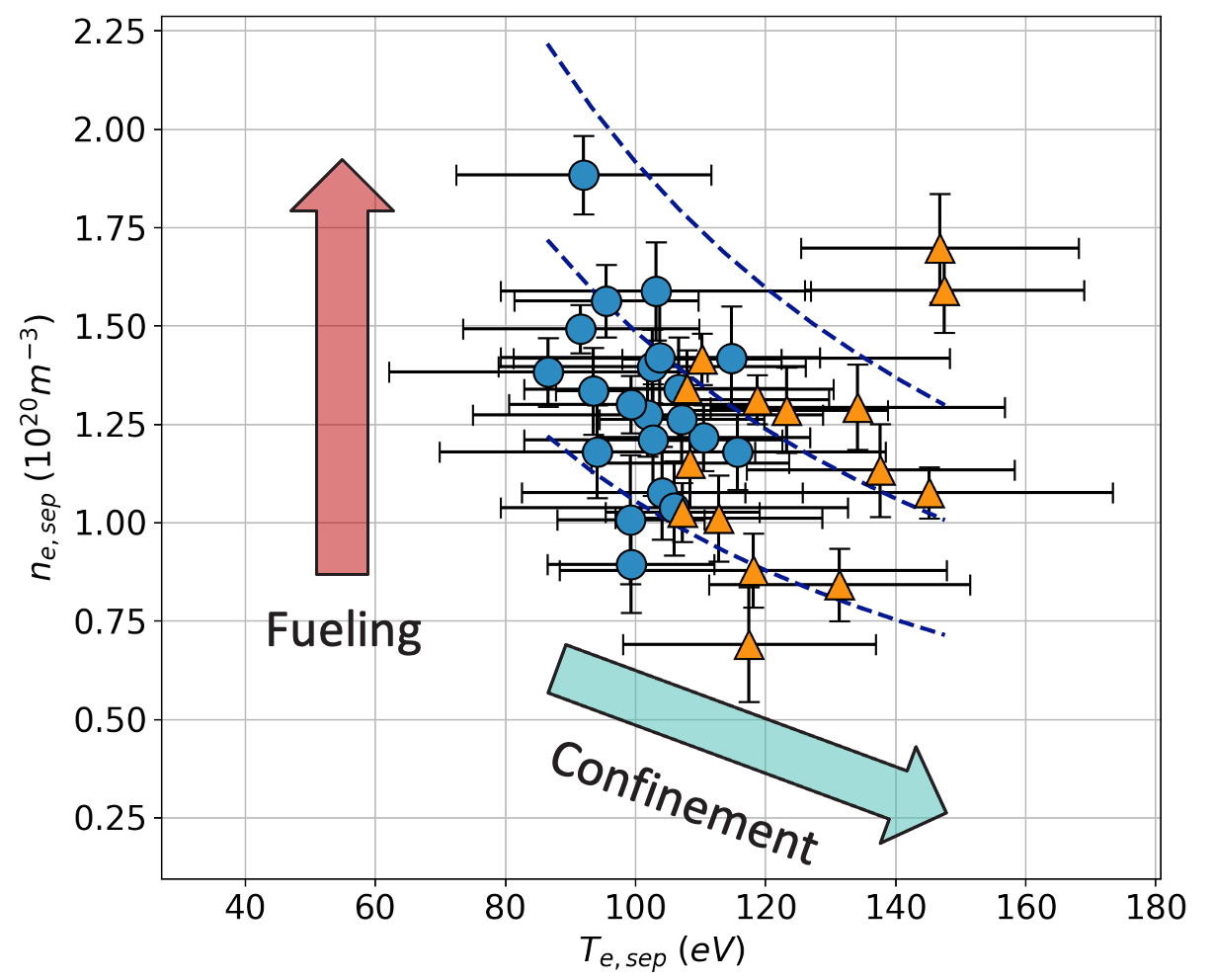
UROP Description:
PI: Jerry Hughes
Direct Supervisor: Andres Miller
This project focuses on analyzing plasma density and temperature measurements made on the Alcator C-Mod tokamak, operatingat MIT between 1991-2016. To this day, it holds the record for volume averaged plasma pressure in a magnetic fusion device. While it is no longer operational, the device is among the closest in parameter space to the next generation of devices, as it operated at high magnetic field and high density. Recent interest in the international community in better understanding how conditions in the edge of tokamaks affects core confinement and plasma operation has prompted a renewed study of data from C-Mod in an attempt to improve predictive models for successful operation of tokamak reactors.
The goal of this project is to help develop a streamlined workflow for analyzing Thomson scattering data for database creation and analysis. The student will start by creating routines to identify plasma discharges of interest. The student will then apply existing data analysis routines, while attempting to find ways to streamline and generalize the process for analyzing Thomson scattering measurements. The student will then create an SQL database, populated with all discharges of interest, and look for ways to organize the data and begin identifying trends. Throughout the project, the student will learn about measuring plasma properties in a tokamak, and why predicting things like electron density and temperature profiles are vital to ensuring successful tokamak operation. The project will involve collaboration with scientists across the international community, in particular at the AUG, JET, and WEST tokamaks in Germany, England, and France, as well as with DIII-D in San Diego. The student will also learn about state-of-the art models for plasma edge turbulence and will use Alcator C-Mod as a testbed for evaluating these and making predictions for next-generation devices like SPARC.
Tags:

